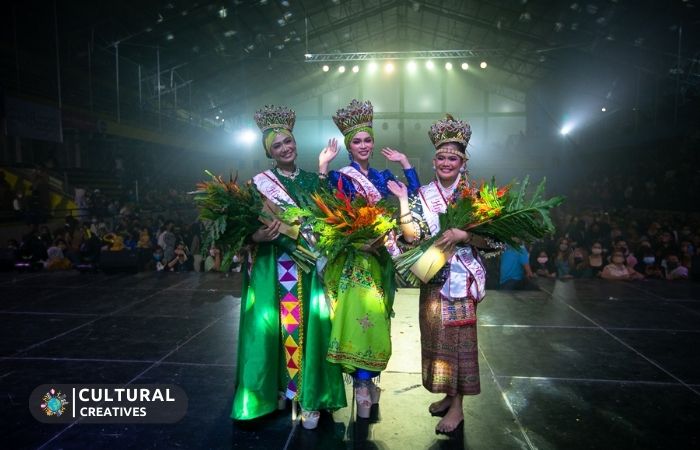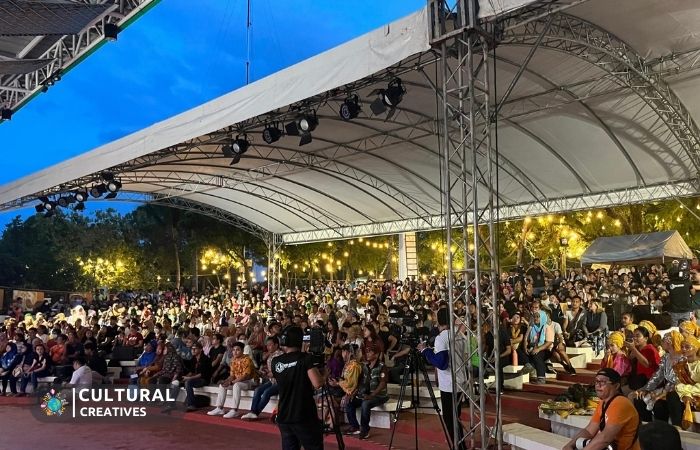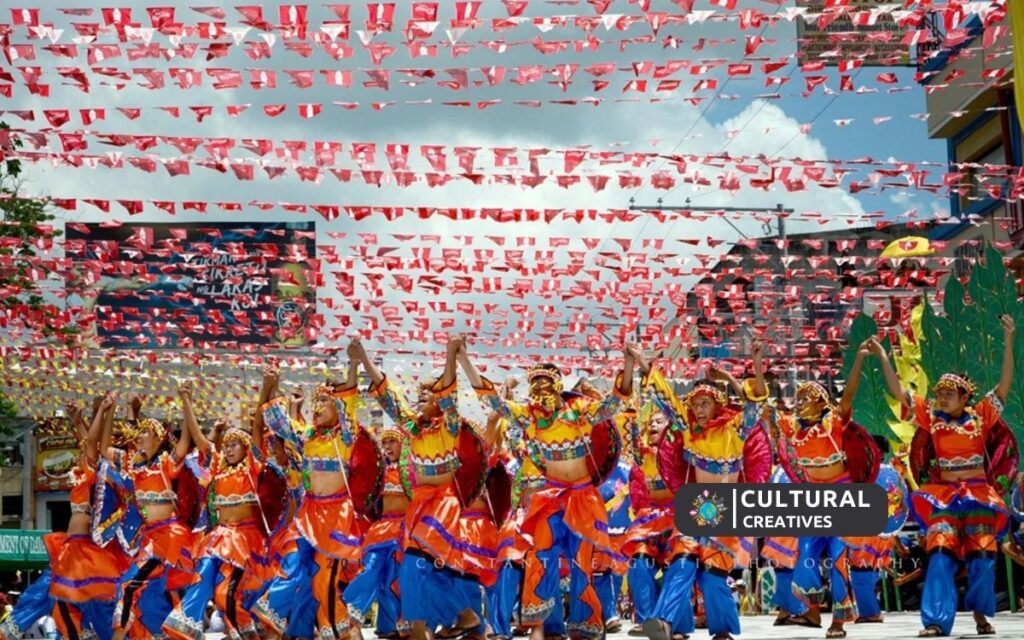The Kadayawan Festival is an annual celebration in Davao City, Philippines, marking the city’s bountiful harvest. It features colorful parades, cultural performances, and street dancing.
Celebration date is in every third week of August, the festival is an expression of Davao’s rich cultural heritage and a thanksgiving for its natural abundance. The name “Kadayawan” is derived from the Mandaya word “madayaw,” a warm and friendly greeting used to explain a thing that is valuable, superior, beautiful, good, or profitable.
The week-long festivities highlight the city’s energy, featuring local products, indigenous music, food fairs, and various competitions. Participants dressed in multicolored, indigenous costumes dance to the beat of drums, gongs, and other native instruments. The event not only boosts tourism but also fosters a sense of community among residents and visitors. The Kadayawan Festival is the perfect blend of tradition and merriment, inviting everyone to experience the spirit of thanksgiving in Davao City.
Kadayawan Festival Place Of Origin And History

The roots of the Kadayawan Festival are deeply engrained in the history of Davao. Initially a thanksgiving ritual conducted by indigenous tribes, the celebration has evolved to honor the bountiful harvests, a testament to the land’s fertility. It’s a fusion of indigenous tradition and modern festivity that commemorates peace, unity, and the region’s rich natural resources. Through street dances and colorful floats, the festival pays homage to Davao’s ancestral heritage and its transformation over the centuries.
Meaning Behind The Name ‘kadayawan’
Deriving from the friendly Dabawenyo greeting, “Madayaw,” which translates to “good,” “valuable,” or “beautiful,” the term Kadayawan echoes the essence of celebration—life, health, and prosperity. It’s a heartfelt tribute to life’s blessings, encapsulating the harmony between humanity, nature, and the divine. This revered festival not only provides entertainment but also serves as a poignant reminder of the city’s storied past and the abundance it has to offer.
The Cultural Tapestry Of Kadayawan

The Kadayawan Festival stands as a showcase of the Philippines’ rich cultural heritage, particularly in the colorful city of Davao. This annual celebration is not just a feast for the senses with its lively parades and vivid displays but also a deep dive into the multifaceted traditions of the indigenous communities. The festival’s origins are deeply tied to thanksgiving rituals for bountiful harvests, life, and health, making it an event where modern merriment meets ancient customs.
The Ethnic Diversity Of Davao’s Indigenous Tribes
At the heart of the Kadayawan lies the spirit of unity in diversity, as Davao’s indigenous tribes, known locally as Lumad and Moro people, come together. Each group brings to the festival a unique cultural signature that reflects their rich historical narratives and lifestyles. Key tribes such as the Bagobo, Mandaya, Mansaka, and the T’boli, among others, converge in this grand celebration, turning Davao into a living museum of cultural anthropology.
- Bagobo Tribe: Known for their intricate beadwork and metal-smith skills.
- Mandaya Tribe: Celebrated for their vibrant and detailed embroidery.
- Mansaka Tribe: Keeps the ancient art of weaving alive through their textiles.
- T’boli Tribe: Renowned for their dream-inspired T’nalak weaves.
Traditional Music, Dance, And Costumes
The Kadayawan Festival transforms into a rhythmic symphony of traditional music and dance, each performance narrating a story of the tribes’ way of life. The resonating beats of traditional instruments like the kulintang, agung, and gongs, provide an auditory backdrop to the hypnotic movements of cultural dances. Participants adorn themselves in handwoven costumes drenched in the colors of nature: earthy browns, greens, and the deep blues of the sea. These costumes not only represent the tribes’ skilled craftsmanship but also their intrinsic connection to the natural world.
Costumes and Ornaments reflect status and achievements, often embellished with beads, shells, and ancestral patterns. Dancers wear them with pride, moving in fluid motions that echo the stories of their ancestors and the land that nurtures them.
Exploring The Key Symbols And Rituals
Kadayawan’s core is steeped in symbols and rituals that hold profound significance for the participating tribes. Rituals like the Pamulak Kadayawan, a floral float parade, and Indak-Indak sa Kadalanan, a street dancing competition, are more than just spectacles; they are acts of homage to the life-giving force of nature and the community’s unity.
Symbols such as the bountiful fruits, flowers like the Waling-Waling orchid, the soaring Philippine Eagle, and the majestic Mt. Apo, are integral to the festival’s theme. These icons are revered for their sacredness in the tribes’ cosmology. The Paunyal, the ceremonial offerings to deities, and the Kaan Kawayan, the bamboo cooking ritual, immerse participants and onlookers in age-old traditions that foster respect for culture and nature.
Key Events And Attractions

The Kadayawan Festival is Davao City’s premier cultural event, celebrating the city’s rich heritage and bountiful harvest. Visitors from around the world flock to this annual fiesta to experience the colorful traditions and the warm hospitality of its people. In this section, we delve into the heartbeat of the festival through its key events and attractions that truly capture the spirit of Davao’s diversity.
The Grand Street Dancing Parade: Indak-indak Sa Kadalanan
At the core of the Kadayawan festivities is Indak-Indak sa Kadalanan, a dynamic street dance competition. This event is an explosion of color and rhythm as performers ethnic attire and move to the beat of tribal drums. Local students and dance troupes take to the streets to showcase the stories of Davao’s indigenous people through dance.
Flower Float Parade: Pamulak Sa Kadayawan
Adding to the festival’s charm is the Pamulak sa Kadayawan, a parade that features floats adorned with stunning floral arrangements. Each float is an artistic masterpiece, elaborately decorated with Davao’s exquisite assortment of flowers and fruits, encapsulating the city’s moniker as the “City of Bloom.”
Culinary Showcases And Local Delicacies
- Taste the flavor of Davao in various food stalls and culinary events.
- Sample exotic fruits and regional specialties, such as durian and grilled tuna.
- Participate in cooking demonstrations led by local chefs, revealing the secrets behind savory Mindanao cuisine.
Beauty Pageants And The Crown For Mutya Ng Kadayawan
The Mutya ng Kadayawan is a highlight for many, a pageant that honors the beauty and intelligence of Davao’s young women. It’s not just a beauty contest; contestants are also ambassadors of their respective tribes, promoting cultural understanding and diversity.
Contemporary Concerts And Fireworks Display
As night falls, Kadayawan comes alive with electrifying contemporary concerts featuring popular local and national artists. The sky illuminates with a grandiose fireworks display, a fitting crescendo to the festivities, making the Kadayawan Festival an unforgettable experience.
Kadayawan’s Impact And Significance

The Kadayawan Festival, hailing from the heart of Davao City in the Philippines, is more than just a spectacular display of color and revelry; it holds deep significance in cultural preservation, economic development, and the promotion of tourism. As a harmonious celebration of thanksgiving for bountiful harvests and the melting pot of cultures in Davao, Kadayawan has had far-reaching impacts on various facets of society.
Boosting Local Tourism Through Festivity
The Kadayawan Festival is a magnet for travelers, both local and international. With its explosive array of parades, traditional dances, and floral floats, it captures the essence of Davao’s rich heritage. Tourism spikes during the festival period as thousands flock to witness the splendor, resulting in an uptick in hotel occupancy rates, increased usage of transport services, and bustling local markets.
- Prompt increase in flight and accommodation bookings.
- Rise in tourism-inspired business opportunities.
- Enhanced visibility for Davao City on an international platform.
Fostering Cultural Understanding And Preservation
The soul of Kadayawan lies in its ability to unite the rich tapestry of Davao’s indigenous communities and modern settlers. It acts as an educational conduit, showcasing traditional crafts, customs, and cuisine through interactive experiences and exhibitions.
- Emphasizes the importance of cultural diversity and harmony.
- Promotes the teachings and traditions of native and lumad groups to younger generations.
Through such initiatives, the festival encourages respect and appreciation for cultural heritage, ensuring it continues to thrive for years to come.
The Economic Implications For Davao City
Davao City’s economy receives a boost each time Kadayawan comes around. Local vendors, artisans, and entrepreneurs eagerly await the festival to showcase their products and services to a wider audience. This groundswell of commerce translates to sharp increases in local business revenues.
| Aspect | Benefit |
|---|---|
| Business Growth | New and repeat patronage for various businesses |
| Job Creation | Short-term and permanent employment opportunities |
| Investment Inflow | Attracts investors intrigued by the city’s economy |
As a direct result, Davao City experiences ongoing development, enhancing infrastructure and improving public services, which circles back to further amplify its allure as a prime destination for tourism and business alike.
Experiencing Kadayawan Festival

Each year, the Kadayawan Festival erupts in a display of color, dance, and cultural celebration on the streets of Davao City, Philippines. This annual event, held every third week of August, showcases the richness of Davao’s indigenous traditions and the bountiful harvest of its lands. Join the festivities and immerse yourself fully into the spirit of thanksgiving and cultural appreciation that is Kadayawan.
Tips For Visitors Attending The Festival
- Plan your itinerary: Map out the events you want to attend and the locations beforehand to maximize your time.
- Dress appropriately: Opt for light, breathable clothing and comfortable footwear as you’ll be on your feet most of the day.
- Stay hydrated: Always carry a water bottle with you to beat the heat and stay hydrated.
- Bring cash: Many vendors at the festival may not accept cards, so it’s prudent to have cash on hand for purchases and food.
- Capture memories: Charge your devices and be ready to take photos and videos, but always ask for permission before photographing locals.
Safety Measures And Community Involvement
The safety of participants and spectators is paramount during Kadayawan Festival. Local authorities implement security protocols and traffic re-routing to ensure a smooth experience. Here are key points:
| Aspect | Detail |
|---|---|
| Security personnel | Stationed throughout the festival area |
| Medical stations | Available for any health-related emergencies |
| Lost and found | Centers set up for missing items or individuals |
Visitors are encouraged to participate in community-led events and support local artisans by purchasing their crafts. This involvement not only enhances your experience but also contributes to the livelihood of the indigenous people.
Related: 31 List of Festivals in the Philippines you must read.
How To Engage With The Culture Respectfully
To truly honor the culture represented at Kadayawan, remember the following:
- Learn about the tribes: Educate yourself on the various ethnic groups of Davao to appreciate their customs and significance within the festival.
- Observe traditions: Show respect by observing local customs, especially during ceremonial events.
- Be mindful of attire: Steer clear of wearing traditional garments as fashion statements unless explicitly invited to do so.
- Ask before interacting: Engage with locals and performers by asking permission before taking part or photographing them.
By engaging with the Kadayawan Festival’s culture with understanding and respect, visitors contribute positively to an environment of mutual appreciation and celebration of heritage.
The Future Of Kadayawan

The Kadayawan Festival, a beacon of culture and tradition in Davao City, faces an evolutionary path laden with both challenges and burgeoning opportunities. As we ponder its trajectory, the integration of modernity and heritage preservation remains a delicate dance for festival organizers and participants alike. Let’s delve into the aspects that shape the future of Kadayawan, highlighting its potential as a pillar of Philippine festival culture and an enduring celebration of life, abundance, and gratitude.
Challenges And Opportunities For The Festival
Kadayawan’s continuity is a tightrope walk between modernization and cultural integrity. Not only must the festival adapt to technological advancements and changing social dynamics, but it must also overcome the logistical hurdles imposed by an increasingly complex world. Below are pivotal points that define its landscape:
- Preserving Authenticity: Amidst commercialization, staying true to indigenous traditions is paramount.
- Environmental Impact: Implementing sustainable practices ensures Kadayawan remains eco-conscious.
- Inclusivity: Fostering an environment where all communities are represented and can participate.
- Digital Engagement: Utilizing online platforms to reach a global audience and spark fresh interest.
The Role Of Kadayawan In Philippine Festival Culture
As one of the most prominent celebrations in the country, Kadayawan plays a pivotal role in showcasing the colorful tapestry that is Philippine culture. It is much more than a local festivity; it’s a national treasure. Icons such as the decorated floats and the rhythmic street dancing are not only crowd-pleasers but are also symbolic anthems of the nation’s diverse heritage.
- Represents the rich cultural heritage of Mindanao.
- Strengthens the bond of community among Filipino people.
- Boosts tourism, thereby contributing to local and national economies.
- Provides a platform for artistry and creative expression.
Sustaining The Spirit Of Celebration
To ensure Kadayawan endures the test of time, concerted efforts must revolve around innovation while honoring tradition. Education initiatives, community participation, and youth involvement are critical to carrying the torch forward. The spirit of the festival can be sustained through:
| Aspect | Strategy |
|---|---|
| Educational Programs | Workshops and school engagements to inculcate the festival’s significance. |
| Community Involvement | Empower local artisans and performers through ongoing support and recognition. |
| Technological Integration | Use social media and virtual reality to enhance accessibility and participation. |
| International Outreach | Forge partnerships that spotlight Kadayawan on a global stage. |
Embracing a balanced blend of tradition and progress ensures that Kadayawan will not only persevere but also flourish in an ever-evolving cultural landscape. This storied festival, with its deep roots and boundless potential, promises to remain a touchstone of Filipino identity and pride.
Conclusion
As the Kadayawan Festival wraps up, we’re left inspired by Davao’s culture. This annual celebration showcases Mindanao’s rich heritage and bountiful harvests, a true feast for the senses. Don’t miss the chance to experience this remarkable event, where tradition meets modern revelry.
Plan your trip for next year and join the festivities that honor life, nature, and diverse culture.


